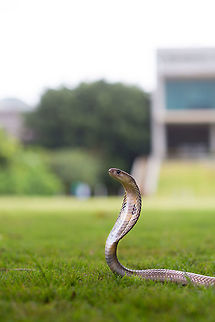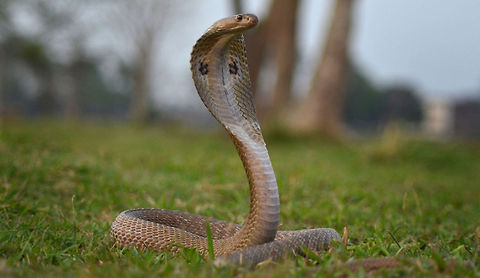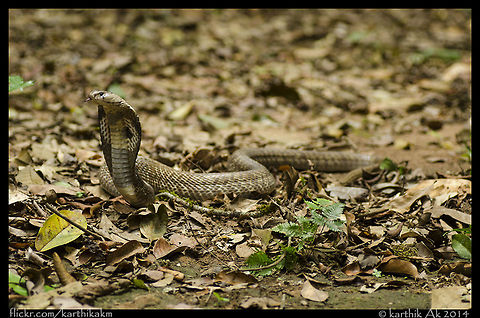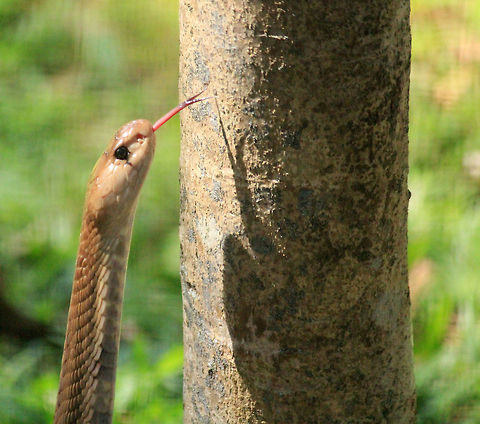
Appearance
The Indian cobra is a moderately sized, heavy bodied species. This cobra species can easily be identified by its relatively large and quite impressive hood, which it expands when threatened. This species has a head, which is elliptical, depressed, and very slightly distinct from neck. The snout is short and rounded with large nostrils. The eyes are medium in size and the pupils are round. The majority of adult specimens range from 1 to 1.5 metres in length. Some specimens, particularly those from Sri Lanka, may grow to lengths of 2.1 to 2.2 metres , but this is relatively uncommon.
Naming
''Naja naja'' was first described by Swedish physician, zoologist, and botanist Carl Linnaeus in 1758. The generic name and the specific epithet ''naja'' is a Latinisation of the Sanskrit word ...snipped... meaning "cobra".The Indian cobra or spectacled cobra, being common in South Asia, is referred to by a number of local names deriving from the root of ''Nag'' , ''Moorkan'' , ''Naya-නයා'' , ''Nagu Pamu'' , ''Nagara Havu'' , ''Naga Pambu'' or ''Nalla pambu'' "Phetigom" and ''Gokhra '' .

Habitat
This species inhabits a wide range of habitats throughout its geographical range. It can be found in dense or open forests, plains, agricultural lands , rocky terrain, wetlands, and it can even be found in heavily populated urban areas such as villages and city outskirts, ranging from sea-level to 2,000 metres in altitude. This species is absent from true desert regions. The Indian cobra is often found in the vicinity of water. Preferred hiding locations are holes in embankments, tree hollows, termite mounds, rock piles and small mammal dens.
Reproduction
Indian cobras are oviparous and lay their eggs between the months of April and July. The female snake usually lays between 10 to 30 eggs in rat holes or termite mounds and the eggs hatch 48 to 69 days later. The hatchlings measure between 20 and 30 centimetres in length. The hatchlings are independent from birth and have fully functional venom glands.![Indian Spectacled Cobra (Juvenile) Naja naja The Indian cobra (Naja naja) also known as the Spectacled cobra, Asian cobra or Binocellate cobra is a species of the genus Naja found in the Indian subcontinent (Pakistan, India) and a member of the "big four" species that inflict the most snakebites on humans in India. This snake is revered in Indian mythology and culture, and is often seen with snake charmers. It is now protected in India under the Indian Wildlife Protection Act (1972).
Naja naja was first described by Swedish physician, zoologist, and botanist Carl Linnaeus in 1758. The generic name and the specific epithet naja is a Latinisation of the Sanskrit word nāgá (नाग) meaning "cobra".
The Indian cobra or spectacled cobra, being common in South Asia, is referred to by a number of local names deriving from the root of Nag (नाग) (Hindi, Oriya, Marathi), Moorkan, മൂര്ഖന് (Malayalam), Naya-නයා (Sinhalese), Nagu Pamu (Telugu),[8] Nagara Havu (Kannada), Naga Pambu or Nalla pambu (நாகப் பாம்பு/நல்ல பாம்பு) (Tamil) "Phetigom" (Assamese) and Gokhra (গোখরো) (Bengali).
Geotagged,India,Indian cobra,Naja naja,indianspectacledcobra,juvenile,najanaja](https://s3.amazonaws.com/media.jungledragon.com/images/2613/34829_small.jpg?AWSAccessKeyId=05GMT0V3GWVNE7GGM1R2&Expires=1769040010&Signature=hM9IgETlxJD94VMq%2BZK991Ns%2FRE%3D)
Defense
The Indian cobra's venom mainly contains a powerful post-synaptic neurotoxin and cardiotoxin. The venom acts on the synaptic gaps of the nerves, thereby paralyzing muscles, and in severe bites leading to respiratory failure or cardiac arrest. The venom components include enzymes such as hyaluronidase that cause lysis and increase the spread of the venom. Envenomation symptoms may manifest between 15 minutes and 2 hours following the bite.In mice, the SC LD50 range for this species is 0.45 mg/kg – 0.80 mg/kg. The average venom yield per bite is between 169 and 250 mg. Though it is responsible for many bites, only a small percentage are fatal if proper medical treatment and anti-venom are given. Mortality rate for untreated bite victims can vary from case to case, depending upon the quantity of venom delivered by the individual involved. According to one study, it is approximately 15–20%. but in another study involving victims who were given prompt medical treatment, the mortality rate was only 7%.
The Indian cobra is one of the Big four snakes of South Asia which are responsible for the majority of human deaths by snakebite in Asia. Polyvalent serum is available for treating snakebites caused by this species. Zedoary, a local spice with a reputation for being effective against snakebite, has shown promise in experiments testing its activity against cobra venom.
The venom of young cobras has been used as a substance of abuse in India, with cases of snake charmers being paid for providing bites from their snakes. Though this practice is now seen as outdated, symptoms of such abuse include loss of consciousness, euphoria, and sedation.

Cultural
There are numerous myths about cobras in India, including the idea that they mate with ratsnakes.Rudyard Kipling's short story "Rikki-Tikki-Tavi" features a pair of Indian cobras named Nag and Nagaina, whose names were probably inspired by the species' scientific name, ''Naja naja''.
References:
Some text fragments are auto parsed from Wikipedia.